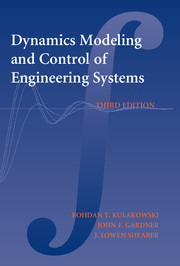Book contents
- Frontmatter
- Contents
- Preface
- Dynamic Modeling and Control of Engineering Systems
- 1 INTRODUCTION
- 2 MECHANICAL SYSTEMS
- 3 MATHEMATICAL MODELS
- 4 ANALYTICAL SOLUTIONS OF SYSTEM INPUT–OUTPUT EQUATIONS
- 5 NUMERICAL SOLUTIONS OF ORDINARY DIFFERENTIAL EQUATIONS
- 6 SIMULATION OF DYNAMIC SYSTEMS
- 7 ELECTRICAL SYSTEMS
- 8 THERMAL SYSTEMS
- 9 FLUID SYSTEMS
- 10 MIXED SYSTEMS
- 11 SYSTEM TRANSFER FUNCTIONS
- 12 FREQUENCY ANALYSIS
- 13 CLOSED-LOOP SYSTEMS AND SYSTEM STABILITY
- 14 CONTROL SYSTEMS
- 15 ANALYSIS OF DISCRETE-TIME SYSTEMS
- 16 DIGITAL CONTROL SYSTEMS
- APPENDIX 1 Fourier Series and the Fourier Transform
- APPENDIX 2 Laplace Transforms
- APPENDIX 3 MATLAB Tutorial
- APPENDIX 4 Simulink Tutorial
- Index
2 - MECHANICAL SYSTEMS
Published online by Cambridge University Press: 05 June 2012
- Frontmatter
- Contents
- Preface
- Dynamic Modeling and Control of Engineering Systems
- 1 INTRODUCTION
- 2 MECHANICAL SYSTEMS
- 3 MATHEMATICAL MODELS
- 4 ANALYTICAL SOLUTIONS OF SYSTEM INPUT–OUTPUT EQUATIONS
- 5 NUMERICAL SOLUTIONS OF ORDINARY DIFFERENTIAL EQUATIONS
- 6 SIMULATION OF DYNAMIC SYSTEMS
- 7 ELECTRICAL SYSTEMS
- 8 THERMAL SYSTEMS
- 9 FLUID SYSTEMS
- 10 MIXED SYSTEMS
- 11 SYSTEM TRANSFER FUNCTIONS
- 12 FREQUENCY ANALYSIS
- 13 CLOSED-LOOP SYSTEMS AND SYSTEM STABILITY
- 14 CONTROL SYSTEMS
- 15 ANALYSIS OF DISCRETE-TIME SYSTEMS
- 16 DIGITAL CONTROL SYSTEMS
- APPENDIX 1 Fourier Series and the Fourier Transform
- APPENDIX 2 Laplace Transforms
- APPENDIX 3 MATLAB Tutorial
- APPENDIX 4 Simulink Tutorial
- Index
Summary
LEARNING OBJECTIVES FOR THIS CHAPTER
2–1 To apply constitutive equations for the fundamental translational and rotational mechanical components: lumped mass, springs, and dampers.
2–2 To derive correct equations of motion for systems involving multiple instances of these fundamental components, some of which may be nonlinear.
2–3 To apply a linearization procedure based on Taylor series expansion to approximate nonlinear systems with simplified linear models.
INTRODUCTION
As indicated in Chap. 1, three basic ideal elements are available for modeling elementary mechanical systems: masses, springs, and dampers. Although each of these elements is itself a system with all the attributes of a system (inputs, parameters, state variables, and outputs), the use of the term “system” usually implies a combination of interacting elements. In this chapter, systems composed of only mechanical elements are discussed. In addition to the translational elements (moving along a single axis) introduced in Chap. 1, a corresponding set of rotational elements (rotating about a single axis) is introduced to deal with rotational–mechanical systems and mixed (translational and rotational) systems.
Also, this chapter deals with only so-called lumped-parameter models of real mechanical systems. In certain situations, such as modeling a real spring having both mass and stiffness uniformly distributed from one end to the other, suitable lumped-parameter models can be conceived that will adequately describe the system under at least limited conditions of operation.
- Type
- Chapter
- Information
- Dynamic Modeling and Control of Engineering Systems , pp. 14 - 53Publisher: Cambridge University PressPrint publication year: 2007

